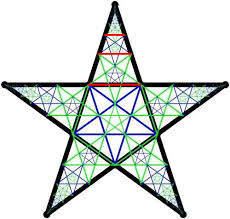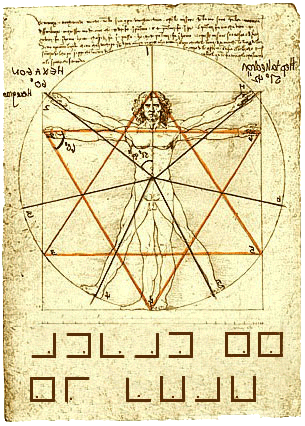This blog I’m exploring a few numbers in Dan Brown’s The DaVinci Code, my book, I Found All the Parts, and another fascinating novel I recently devoured, The Ezekiel Code.
Numbers became a big deal for me on my journey with rock music. Shortly after my awakening, the number “four” camped out in my brain with a lawn chair. The words “archetype” and “everyone” also did the cha-cha in my skull for many months, but I had no idea at the time why I was hearing this crap. Since they were like annoying neighbors who frequently visited me on a daily basis to borrow a cup of sugar, I knew the words were important clues on my journey. But why would a number be significant?
Numerology, the system, tradition or belief in a mystical or esoteric relationship between numbers and physical objects or living things, goes way back. Pythagoras, the dude who gave us the Pythagorean Theorem, was into the spirituality of numbers big time. He thought every number resonates at a unique frequency. Kind of like music. Just as the note middle “C” vibrates at the frequency of 256 cycles per second, the numbers 1-9 are also believed to resonate to different energies and therefore offer insight into ourselves and our world.
The Davinci Code’s smart and handsome Professor Langdon illustrates how the five sided pentagram, or pentacle symbol, is considered both divine and magical by many cultures. That’s because if you draw a pentagram, the lines divide themselves into segments according to the Divine Proportion, aslo called PHI = 1.618.

Phi is s a symbol of beauty and perfection and connected with nature, the goddess, and the sacred feminine.

My journey as a woman with rock music helped me get in touch with the sacred feminine through various avenues, but especially via numbers. I began to see the correlations between music, numbers and sacred geometry in spectacular ways. The Divine Proportion, or 1.618, is everywhere in nature and even in different proportions of the human body.

The black and white keys on a piano represent the ratios of musical proportion as well. (from http://www.miqel.com/jazz_music_heart/vibrational-truth.html)

Phi is closely related to the Fibonacci series. In the 12th century, Leonardo Fibonacci discovered a simple numerical series that is the foundation for an incredible mathematical relationship behind phi. Starting with 0 and 1, each new number in the series is simply the sum of the two before it.
0, 1, 1, 2, 3, 5, 8, 13, 21, 34, 55, 89, 144, . . .
The ratio of each successive pair of numbers in the series approximates phi (1.618. . .) , as 5 divided by 3 is 1.666…, and 8 divided by 5 is 1.60. After the 40th number in the series, the ratio is accurate to 15 decimal places. 1.618033988749895 . . .
Since my book delves into alchemy, codes, symbols, and the Rosicrucian Dr. Robert Fludd, I wondered if 1.618 might be a code for me. Think, think, think. Aha! Take the decimal away from 1.618 and ya get the year 1618. In 1618 Fludd wrote De Musica Mundana (Mundane Music) which described his theories of music, including his mundane (also known as “divine” or “celestial”) monochord. And look. God is tuning the chord so it sounds nice for us.

Interestingly, Fludd’s image is all about proportion and illustrates the mathematical properties of musical pitch. In music, the 5th note of a scale (for example G in a C scale, also called a fifth) creates a 2:3 ratio or .666. Therefore, as noted above, if you play a fifth, such as C and G together, it is considered the musical representation of Phi and sounds very harmonious sound to our ears.
 Gary Val Tenuta explores Phi and the Divine Proportion in The Ezekiel Code as well. Tenuta calls his form of numerology, whereby each letter represents a number; 1 = A, 2 =B, so on up to Z=26, crypronumerology. On his website, he writes that the term “crypto” relates to the idea of secret writing, ciphers, and codes. Therefore, any word or group of words has a numerical value (by tallying the numbers associated with the letters in the word or group of words). This is important since some consider that numbers not only have quantitative values, but qualitative values as well. “In this sense,” says Tenuta “one might think of numbers as being resonant symbols reflecting archetypal concepts residing in what the Swiss psychologist, Carl Jung, called the collective unconscious.”
Gary Val Tenuta explores Phi and the Divine Proportion in The Ezekiel Code as well. Tenuta calls his form of numerology, whereby each letter represents a number; 1 = A, 2 =B, so on up to Z=26, crypronumerology. On his website, he writes that the term “crypto” relates to the idea of secret writing, ciphers, and codes. Therefore, any word or group of words has a numerical value (by tallying the numbers associated with the letters in the word or group of words). This is important since some consider that numbers not only have quantitative values, but qualitative values as well. “In this sense,” says Tenuta “one might think of numbers as being resonant symbols reflecting archetypal concepts residing in what the Swiss psychologist, Carl Jung, called the collective unconscious.”
AHA! Numbers are archetypal! That must be why I kept hearing “archetype” and the number “four” after my awakening. Getting back to PHI and the Divine Proportion, The Ezekiel Code offers numbers and musical references up the yin/yang. For instance, THE GOLDEN MEAN SPIRAL = 198 = THE MUSICAL SCALE OF GOD and PHI SPIRAL = 108 = GEOMETRY. THE MUSICAL PHI = 144. THE DIVINE PROPORTION = 252 = CHRIST CONSCIOUSNESS = ALCHEMICAL TRANSMUTATION. In case you didn’t notice, all of these numbers add up to 18 or 9 (18 or 1+8=9). Many of the hidden messages in The Ezekiel Code total 9, and Tenuta believes 9 represents “synchronicity.”
Reading The Ezekiel Code was a blast because there were numerous synchronicities between the numbers and my own journey. Synchronicity to me indicates that everything is connected, and my thoughts attract situations/people/information to me when I’m in a place of allowing. The synchronicities I encountered on my spiritual journey with a famous rock band are so prolific, so freaking mind-blowing, that it left no doubt that our consciousness expands beyond our physical mind.
In an upcoming blog, I’ll delve into several important numbers I encountered on my journey: Too, Fore, Sicks, Ate, Who Do We A-Pre-She-8? (and maybe Sicksteen too).
